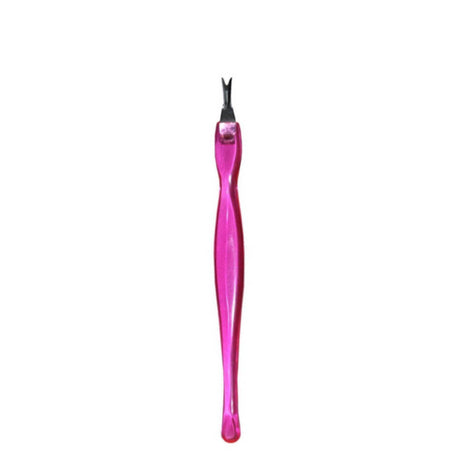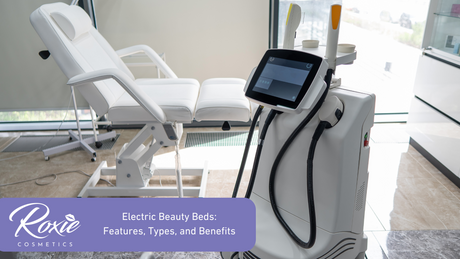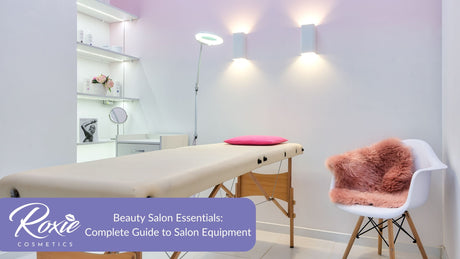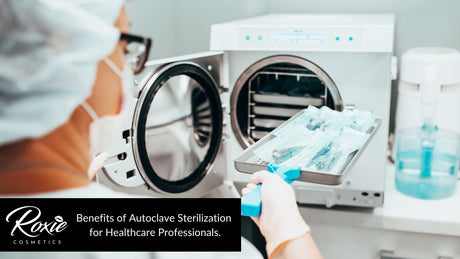Everyone dreams about clean and healthy skin, but pollution, oily or combination skin and makeup can worsen its condition and lead to enlarged pores and their clogging and, as a result, to blackheads, whiteheads or acne. This can be stopped, but you have to act as soon as the black dots appear on your skin and even better, prevent them from surprising you. There are lot of options to implement into your skincare to improve it and you have to focus on your pores and learn how can they be effectively removed. Most experts’ advice is to be consistent and regularly exfoliate your skin, but this is far more complex. So, read on to get to know the details!
WHAT ARE BLACKHEADS?
A blackhead, also known as a comedo, is an oxidized mixture of impurities - simply, it is an open pore (hair follicle) which becomes clogged with excess oil, dead skin cells and bacteria, and turns black under the influence of the air.
WHAT IS THE DIFFERENCE BETWEEN WHITEHEADS AND BLACKHEADS?
Both sit deep in your pores, and both are caused by the residues of makeup, dead skin cells, and sebum, but whiteheads are in closed pores (literally white lumps resulting in breakouts), whereas blackheads – the ugly, tiny black spots - reside in the open pores (and thus become oxidized).
WHY DOES IT HAPPEN?
Hair follicles produce sebum thanks to sebaceous glands. They protect your skin and moisturise it with oil. It is especially important for dry skin as it prevents it from losing water. The excess of sebum, however, can lead to several skin conditions such as oily skin, which gives you an unhealthy look, or blackheads and acne. You can try to reduce it, but mind you, that the oil production is an ongoing process which aims at protecting the surface of the skin, hence is not bad for you, and you shouldn’t be too harsh on your skin trying to mattify it. Yet, the excess of sebum with dirt and residues of makeup clog pores, and become nonetheless a problem which you should accurately treat with the help of proper products good for a given skin type. It’s especially problematic for acne prone skin, since the excess sebum may make your condition worse.
PROPER BLACKHEADS TREATMENT
First, don’t overdo with squeezing blackheads, as it may lead to inflammation, scarring and spread of bacteria! You should leave this task to a professional extraction facial specialist. If, however, you really need to do it, do it with your fingers covered with a tissue (because you hands can transfer a lot of bacteria) but we urge you to choose only on the oldest (the blackest) blackheads – new ones tend to be resistant to squeezing, and thus prone to irritation and contamination. If in doubt, whether or not you’re doing it right, avoid the urge to pick the blackheads.
Prior to this process, take a bath or shower, or lean your face over the bowl of hot water to let the steam loosen the pores. Remember to squeeze around the pore – putting too much pressure only on the same sides of the pore may be painful and can break the fine walls of the follicle. If the blackhead is not coming out, don’t push it – better wait a couple of days before doing it again. It’s better to book a visit at beautician’s (especially if you have sensitive skin) for a pore cleansing treatment done by an expert who will do it skilfully and gently to your skin.
However, regular visits can cost you a lot of money, therefore you should try some do-it-yourself methods! With help of well-matched cosmetics and systematic purifying and scrubbing routine, you can combat oily skin and clogged pores. The key is to follow some dos and don’ts of blackhead removal.
DO:
- Moisturise – oily skin gets treated with cleansers that dry out skin. Use a light moisturiser to level hydration. We recommend also oil-free sunscreens with SPF to protect your skin from UV rays causing pores to become open. Remember to reapply it, especially on T-zone which produces usually more oil than other areas, which means that the sunscreen is more likely to dissolve there making your skin more prone to sunburn. Use oil-free cosmetics – your sebaceous glands already care for covering your skin with protecting sebum, oil is a redundant ingredient in most of the creams for oily complexion.
- Wash – this is basic, but important step - clear your skin twice a day with cleansers that focus on removing blackheads. The main reason why blackheads appear is combination of impurities that access your pores, therefore start your morning and finish a day with a healthy habit.
- Balance the pH – using a pore-closing toner after you wash your face with gel and water will help normalise your skin condition. Making your skin regain its neutral pH will prepare your skin for a next step, which is a moisturiser.
- Exfoliate – use a mild exfoliant, or a soft silicone brush, or an enzymatic peeling in form of mask that will gently exfoliate your skin if you have sensitive or prone to redness skin (regularly, twice a week) to remove dead skin cells that may clog your pores. Applying cosmetics with AHA (alpha-hydroxy-acids) ingredients, like lactic acid that absorbs the oil, allows for best blackhead removal, while using BHA (beta hydroxy acids), like salicylic acid, enhances the exfoliation of outer layer of your skin cells. Read more about the wholesome properties of salicylic acid here.
- Put a mask on – use a blackhead remover face mask or a blackhead extraction paste once a week. There are a lot of types of masks specifically targeted to fight with acne, for example a clay or a charcoal mask. Leaving a mask for a few minutes will detoxify and absorb the dirt. Pore strips also often prove to be more effective, especially on your nose - they peel off your blackheads, draw the dirt out of the pore. You can try some overnight masks or serums that will take care of your pores (and when we’re discussing sleeping, remember to change your pillowcases weekly not to let bacteria multiply). Applying a soothing, anti-inflammation cream afterwards is advisable, particularly for sensitive skin. If blackheads tend to appear only on some parts of your face (for instance only on your nose or your T-zone), pick topical serums to shrink the size of your pores.
- Consult with dermatologist – in some cases (for example when you see that over-the-counter cosmetics don’t work) clogged pores need to be dealt with help of a doctor and medicine. A dermatologist will discuss with you a plan on how to best handle your concerns with acne and blackheads, and prescribe suitable cosmetics and vitamins. Adjusting cosmetics to different skin types which will scrupulously clean and care for your complexion is crucial for treatment to be efficacious. To medical ingredients that work best for comedo prone skin belong for instance products with retinoids, which fight blackheads and increase exfoliation (in case of these products, remember to be patient, since it is a long-lasting treatment). Sometimes the issue is based in the lifestyle, and thus changes in the diet might be introduced as part of prescription. Often an expert advice is the best solution. And when it comes to special treatment, oftentimes beauty salon is the place where women receive best tips and treatment. Microdermabrasion, chemical peel, facials with glycolic acid, hyaluronic acid, or benzoyl peroxide are just a few of the great ways to fight blackheads and acne.
- Use non-comedogenic cosmetics – meaning not clogging your pores. Always search for the ones which are labelled as non-comedogenic and for safety opt for light cosmetics like for example liquid foundation or simple, moisturising cream. In most cases, oily skin will produce sebum despite using mattifying cosmetics anyway, and we can all agree that applying more and more layers of foundation or powder will only make it look worse.
- Work out – being active helps get rid of the toxins that sit inside your body and benefits your health, and thus may help fight with acne. Join fitness club, or go jogging, whatever type of workout suits you but…
DON’T:
- Sit in sweaty clothes – naturally, you take a shower after a workout session, but sometimes you let yourself rest longer than you should. Sweat and toxins you’ve just released from your body may also clog the pores on your skin. Hence, if you spot a pimple after working out, it sure is its fault. It doesn’t mean you should give it up, just take the shower and change the clothes as soon as possible. Wash too frequently – oily skin can be pesky and you may want to wash the oil away too many times a day. In turn, this may dry out your skin. Use a mattifying papers instead that will absorb the excess of sebum. Scrub too hard – use a gentle scrub or enzymatic one, if you notice that a thick-grained peeling is a bit rough on your skin. It is a very personal thing, not all the skin types are the same, so find your favourite scrub or peeling that will provide you with effective exfoliation without damaging your skin.
- Overdo with salicylic acid – although it is recommended to use an exfoliant with this acid, you should be careful since it may dehydrate your skin and lead to excessive production of sebum. Once or twice a week will be sufficient, if not too much – observe your skin and if you see that it starts scaling, skip salicylic acid for a while.
- Use only mattifying cosmetics – although it may be tempting, try not to use oil-controlling cosmetics only. Including in your skincare rituals for instance a pore-closing toner and an oil-free moisturiser will help to restore the moisture level.
You’ve probably noticed that most of the warnings refer to dehydrating your skin. While it may sound impossible for people with oily skin, it is nevertheless quite frequent that their skin becomes dry and irritated despite the efforts of the sebaceous glands. Dehydrating your skin increases the risk of quicker appearance of ageing symptoms such as wrinkles. Opt for moisturising creams or serums of light texture and oil-free formula. You’ll thank yourself in the future.
Pro tip: to save yourself some money and time, go to sites with reviews and read users’ opinions on product before purchasing them – the owners of oily skin are quite likely to warn others of possible shiny effects.
You may also try some natural methods like aspirin or lemon juice toners, baking soda masks or tea tree oil. There are lots of articles and videos on how to target this issue and which method works best, hence it may be a bit confusing. The key is to get to know the needs of your skin – don’t be discouraged and continue to look for most optimal solution for you.
If you’ve neglected your pores for years, it might be a good idea to book a visit at dermatologist’s first. Blackheads on face are upsetting, make your skin look unhealthy and can cause further skin conditions, therefore you should do your best to close your pores and don’t let them become clogged. You need to understand, though, that this is not a one-time process. Even if you succeed and remove your blackheads entirely, they will return after couple of weeks again, so you should make pore cleaning routine your daily habit.



















